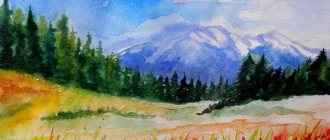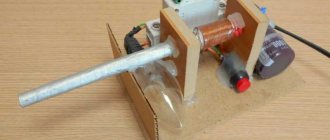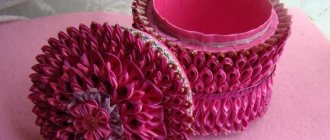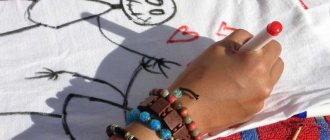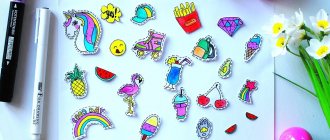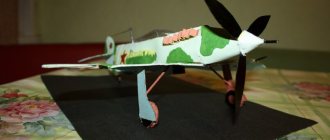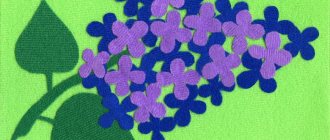Today, 3D drawings on paper are becoming more and more popular; you can look at them for a long time and admire them. Not only talented artists, but also those who are just getting acquainted with fine art can create such masterpieces. It's never too late to learn how to draw; anyone can make spectacular 3D drawings.
The tools you need for 3D are the simplest: a pen, pencils, a marker and a piece of paper. By the way, it is best for beginners to draw using cells in a notebook, as it is much easier to draw figures this way.
It is worth noting that the image is created on paper in stages, in this case the main thing is consistency, even if simple and uncomplicated pictures are reproduced.
Many people are interested in how to draw a 3D drawing on paper with a pencil in a bright and realistic way. To do this, you should use photo instructions or videos that will clearly show all the techniques for recreating a 3D drawing.
Let's look at pencil drawings step by step for beginners. For clarity, print out the drawn images to make your task easier. Please note that the first acquaintance with 3D technology can cause mixed impressions; there is no need to rush, smooth movements and endurance are the main assistants of a novice artist.
So, let's get down to business, let's learn how to draw beautiful 3D drawings.
History of drawings
Images in 3D format appeared in the 16th century. Traveling artists depicted with chalk, on the pavements of medieval streets, paintings depicting the holy face of the Madonna.
Subsequently, the authorities of many cities began to encourage such creativity. The goal is to attract as many tourists as possible and replenish the city budget. But the people still have a love for street art.
3D art
With the advent of computers, 3D street drawing began to give way to 3D computer graphics. The task of 3D modeling is to create a visual, three-dimensional image of the depicted object.
A type of 3D drawings is graffiti, realistic paintings that create the appearance of a three-dimensional scene.
In modern life, three-dimensional art is familiar to the whole world. This is an incomparable, breathtaking spectacle. The paintings, as if born from the earth, fascinate with a riot of colors and a sense of reality.
Step-by-step instruction
The image of three-dimensional drawings, even the simplest ones, is created on paper in stages. The main thing in this process is consistency. Step-by-step instructions provide for all stages of creative work. First of all, you need to have a photo or a finished drawing that you want to reproduce on paper.
When professional artists assure that if you just want to, everyone can draw such pictures, frankly, I can’t believe it. The creative process seems so complicated that many, even wanting to learn, put off their dream until better times. And, meanwhile, in vain.
Having studied the technical nuances of creating three-dimensional paintings and taking several master classes on this topic, everyone can learn how to create realistic images. Perseverance, patience and consistency of learning are what a person who wants to master 3D art needs to stock up on.
Note!
- Graphic dictation by cells for preschoolers and first graders. The easiest and most difficult graphic dictation options for a child
- Dog coloring page - useful tips on how to draw a dog. Instructions with basic drawing steps for children (160 photos)
- Sketches: a master class on creating simple and complex drawings with your own hands with step-by-step diagrams for beginners + photo examples of original works
3D paper paintings | Crafts Master
At first glance, these kinds of crafts seem to be products of incredible complexity, and I will not dissuade you from this. After all, you still have to work hard on them! And before you start work, the main thing is to understand the main principle of creating this kind of painting. How to make a 3D painting is the topic of today’s article.
How to make a picture out of paper
The name 3D itself suggests that the picture has not one layer, but two, three or more. The easiest way is to make a two-layer painting. For example, this birch tree: two layers of branches arranged differently create the effect of one whole, and this is achieved in the following way.
Each layer has a frame, which is made from the same sheet as the drawing itself. Thus, one frame is nested inside another, that is, it closes like a box of chocolates.
Birch on the wall
The figure shows that each picture has a corresponding pair. Simply print out the images, carefully cut out the design with a utility knife, then fold the frame along the fold lines and secure it with glue.
Then you insert both frames into each other.
3D paper paintings
But a painting depicting bamboo was made using the same principle!
3D bamboo
Bamboo on the wall
Recently, there has been a fairly fashionable tendency to create several paintings that continue each other’s plot.
Thus, completely separate paintings, hanging horizontally or vertically at a certain distance from each other, at the same time are one whole, although each lives a separate life. At the same time, most often you should follow a certain order in the arrangement of the pictures, so as not to lose the main plot and not get in return just a set of awkward pictures.
Experiment! Make your home beautiful!
Source
comments powered by HyperComments
masterpodelok.ru
First steps in 3D art
A master class for beginners, as a rule, advises starting the drawing process by repeating someone else's work. If you are a person with a wild imagination, you can imagine an incredible story, but you will not be able to depict it realistically on paper. To do this, you need to understand the logical cycle of constructing a 3D drawing.
Usually, the teaching begins with the simplest thing: an image of one’s own hand. To do this, trace the hand and part of the wrist with a pencil on paper.
Using a felt-tip pen, draw straight lines before and after the outline of the hand, and draw an arc on the hand itself. Such lines are drawn along the entire sheet, at a distance of 1-2 cm from each other. Markers of 3 colors paint over the stripes. Add a shadow around the arm to make it look more voluminous.
Looking at the picture, it seems that the hand is covered with colored elastic paper.
This method of drawing is called "ruling". It is ideal for beginner artists: a simple and effective way.
How to draw a drop of water 3D
You will need pencils, white paper, and skillful hands.
You can draw a drop as shown in the video:
https://www.youtube.com/watch?v=Up0sLULnF9Y
- First a sketch.
- Details of the drop pattern (shimmer, reflection of light, shadow, trace of water).
3d Doorway (or Dungeon)
To create the illusion of a vertical image of the opening, you can add walls and floors:
- Unfold the sheet with the wide side. In the lower right part, draw a rectangular part about a third of the entire area. Connect the upper left corners of the page and the rectangle. This diagonal is the junction of the walls, the rectangle is the floor.
- Line the walls finely parallel to the edges of the sheet. The left side of the diagonal is vertical, the right side is horizontal. The walls are ready.
- Draw a doorway with a rounded top in the left wall, almost in the corner, so that the threshold is at the junction of the wall and the floor.
- The angle between the walls and the floor is a guide for the logical placement of the door. It should be slightly elongated along the left edge so that when viewed at an angle along the diagonal, the proportions are aligned.
- Shade the opening parallel to the threshold, more on the right side.
- Add hinges and a door that opens to the right. The right edge of the door should be parallel to the joint of the walls.
- Detail the door. “Vertical” boards look good.
- Apply shadows. Be sure to shade the borders of the ruling by 2-3 cm around the opening and door to hide the irregularity of the shapes.
Look at an angle of about 30-45 degrees from the lower right corner of the sheet.
3d Butterfly
One of the secrets to the illusion of volume is the cast shadow. The second is changed proportions. The part of the drawing further from the viewer should extend along the line of sight.
The wingspan is not important, but for beginners mastering 3D drawings on paper, it is better to choose the profile option in order to draw one wing instead of two.
The initial sketch of the butterfly is proportional, the bottom edge corresponds to the final location. From here the viewer will see it.
Let's draw:
- Now you need to stretch the image vertically. To do this, divide the sketch vertically into 4 equal parts. Temporary auxiliary lines can be drawn in these places.
- The proportions of the bottom piece do not change. You need to stretch the picture starting from the second part - lengthen it by a quarter, the third by half, and the fourth should be three quarters longer than the original.
- Draw the outline of the drawing, remove everything unnecessary - auxiliary lines and the remains of the first sketch.
- Detail the picture, indicate the pattern of the wings, the fibers on the body, draw the antennae. You can also color it if you wish.
- Add a shadow symmetrically diagonally from the bottom edge of the picture. Darken it completely, feather the borders.
- You can enhance the illusion by cutting off the top of the sheet at about ¾ of the way through the drawing, leaving a piece of the wing protruding beyond the edge of the page.
3d eraser
An eraser is a small object; its 3D copy on paper can be copied literally from life. First you need to arrange your workplace. Secure the sheet so that it does not move during the drawing process, install a lamp so that the light falls from the left.
Let's draw:
- Place the rubber band where it will be drawn. Trace the outline.
- View from the viewpoint chosen for the audience. Mark three points behind the eraser so that they are above its top three corners.
- Remove the eraser. Using the marks, draw the “upper” contour of the elastic band. In this case, the edges will narrow from the foreground to the background. Erase the auxiliary lines inside the figure.
- Put the eraser in place and see how the light falls on it. Outline the cast shadow and move the sample to the side.
- Darken the edges of the drawn eraser, shade it in the right places and enjoy the result.
3d falling man
A very simple 3D illusion - a picture with a man holding on to the edge. The trick is that the character is located on both sides of the sheet at the same time.
How to draw:
- First, draw a figure of a person stretching upward closer to the right edge of the sheet. The upper part of the figure is almost 2 times longer than the lower part, as seen from above. Hands up to the wrists, no palms.
- Measure the distance between the ends of the figurine's arms.
- Turn the paper face down, draw palms with fingers holding the edge of the left side of the sheet approximately in the middle.
- Bend the piece of paper into a semicircle so that the pictures match. If everything worked out, work out the details and paint the little man.
Pencil drawings
Visual, three-dimensional drawings allow you to experience the world in a different way.
Note!
- Easy gouache drawings - TOP-160 photos and step-by-step instructions for drawing with gouache. Best Reviews of Easy Drawings for Beginners
- Drawing ideas: TOP-200 photos of the best ideas for do-it-yourself drawings + reviews of techniques with simple drawing schemes
- Pencil drawings are easy and beautiful - a master class on pencil drawing for beginners. Simple diagrams with a description of the work + photos of the best drawing ideas
To draw 3D drawings with a pencil, you need to be patient. At the beginning of mastering creativity, there is no need to rush; the pencil should describe smooth lines. By fulfilling these conditions, you yourself will be amazed at your new capabilities.
For this work you only need to stock up on a pencil, an eraser, a ruler and scissors. Any table where you feel comfortable working can become a creative workspace.
Three-dimensional drawings by cells
A simple diagram of drawing a butterfly in a three-dimensional format will allow you to create a miracle drawing that will be so realistic that it seems that the butterfly will flutter and fly away. 3D drawings by cells are easy to perform.
The technique of drawing by cells is most suitable for beginners:
- A sheet of paper needs to be marked with guide lines. - Draw the outline of a butterfly.
- Draw the details of the wings and abdomen.
- Having erased the guide lines with an eraser, you need to begin the process of painting the insect.
- Draw the shadow cast by a butterfly.
- Cut out part of the sheet so that the upper body and wings of the butterfly are outside the sheet.
The drawing is complete.
Note!
How to draw a squirrel: TOP-120 photos of the best drawing methods and techniques. Step-by-step master class for beginners with examples of the best drawings
- How to draw anime - useful tips and simple diagrams for beginners. Instructions with the basic steps of drawing anime (160 photos)
How to draw a girl's face with a pencil - instructions on how to draw with a pencil for beginners. Master class with a description of the technique + photos of the best drawing options
Paper paintings: master class, volumetric paper omnitrix
Cutting out large multi-layered pictures from plain paper is an interesting hobby . If you decide to try your skills in this part of the art, start with simple paper paintings, the production of which will allow you to become familiar with the details of this type of craft.
We offer an easy and detailed master class, which will help you make a large picture cut out of paper with your own hands. This requires very little time, and the materials needed for the work can always be found at home.
Contents of the material
How to make a regular paper picture with your own hands
For work, we will need:
- Wooden frame.
- Paper blue, white, gold.
- Glitter in liquid form.
- Styrofoam.
- Wire.
- Stationery knife.
- Large tape.
- Glue, three different ones.
Process description
Before creating the picture, we will treat the wooden frame with white paint. It is easier to use aerosol paints. Remember that the front part of our product will be the back side of the frame . While the paint dries, you can move on to creating the background. To do this, cut out a rectangle from blue material. It must completely fit the internal dimensions of the frame.
On a white leaf, we will depict several trees with different intersecting branches. To make cutting easier, let's shade a couple of intersections with our pencil. Place a second leaf under the first leaf . Let's move on to cutting out the marked areas. After this, separate the leaves and trim the cuts with a knife.
Slowly fold the edges of both sheets to increase their volume. We will also tuck the tree trunks, creating small cuts and fixing them with our glue. This work is easier to do with an awl. Glue a couple of pieces of foam onto the bottom sheet, and then attach the second sheet to it. Space begins to appear between the paper snowdrifts, which gives the effect of layering and volume.
Now, using our stationery perforation knife, we make a couple of dozen round “snowflakes”. In the same way, cut out a couple of circles (circles) of different sizes from multi-colored paper. If we don’t have it, let’s start working with liquid glitter and make circles.
Let's cut out the moon in the form of a circle and animal figures , and make stars from the yellow material.
On the third leaf of our white material, we depict a tall tree with thin and long branches, and slowly cut it out. When all the details are done, you can move on to assembling the “cut-outs,” as paper paintings are also called. To do this, you need to glue the layers of paper on top of each other one by one.
We also recommend reading:
Our three-dimensional fake is done, it’s time to frame it. Measure the center at the top of the frame and screw the wire into the loop. Then we will pass a wire or rope through the loop so that the product can be hung on the wall. Glue a couple of strips of large tape inside the frame and place the picture evenly.
Craft completed! Now you can safely decorate your home with a paper painting you created yourself.
As you can see, with a little effort and patience, you can create unique paintings.
Gallery: paper paintings (25 photos)
3D paper painting, master class and diagram
To make a 3D picture we will need the following materials and certain simple tools:
- A large frame or a nice box of chocolates.
- A special knife or knife for decoupage.
- A simple pencil.
- Sharp scissors.
- Leaf with print.
- A sheet of white specialty paper or small cardboard.
- Ruler.
- PVA glue.
- First stage. We start by making a blank from white special paper or thin cardboard, in accordance with the dimensions of the selected frame.
- Second phase. Separately, on a piece of strong paper, draw by hand or print using a printer a small heart, measuring four cm in height and five in width. We calmly cut out the sketch we have made along the contour and get the template needed for making a 3D painting from paper.
- Third stage. Next, we apply the created template to our paper blank and trace it in a row a couple of times horizontally and vertically. In the end we will have an image with nine identical hearts. You may get more or fewer hearts, it all depends on the size of the picture frame and the base, according to which we cut everything out.
- Fourth stage. Then, taking a stationery knife or a decoupage knife , we create cuts on both sides of each heart made, leaving only the top and bottom middle of each image untouched.
- Fifth stage. After this, slowly bend both halves of each cut out heart to one side, so that it looks voluminous in appearance.
- Sixth stage. We will paste the created blank with large hearts onto scrap paper with a small print, so that it is visible through the holes made.
- Seventh stage. We insert the finished 3D paper painting into a frame and complete the work on its creation. In approximately the same way, you can make a picture from an accordion, the main thing in this work is that a person knows how to correctly assemble and cut out parts from paper.
Conclusion. Don’t be afraid to start making paper crafts; after simple products, you can start making paintings of flowers, and then you can also sell them.
First drawings
3D drawings for beginners are work done in three-dimensional format. In this case, it is necessary to correctly take into account the height, width and depth.
The basis of the three-dimensional drawing technique is the play of light and shadow.
Before you start drawing, you need to analyze the features and nuances of the selected object: shape, angle of the cast shadow.
The first stage of drawing is to sketch a sketch of the object being drawn and determine the correct location on paper.
The location of the light source affects the cast shadow, this must be taken into account.
Shadows are indicated by moving from a lighter tone to a darker tone.
Using an eraser, the shadows are shaded. This helps to convey the depicted subject more realistically.
Drawings on paper
3D drawings on paper are a picture that comes to life before a person’s eyes.
When drawing on paper, we are well aware that it represents a plane: length and width. In order to give the drawing depth and sufficient volume on this plane, you need to remember about linear perspective, the correct choice of angle, and the location of the light source.
Children love to draw their favorite cartoon characters. You can help them depict, for example, a minion in such a way that it appears to them as if alive on a sheet of paper.
Even first-graders can simply draw a simple minion figure, but they need to learn how to give it volume.
Line the sheet with the image of the minion into strips 1.5 cm wide, without ruling the figure itself.
Connect each line with an arc (it will be on the toy figure). This can add volume to the image. Now apply shadows, taking into account the location of the light source. Apply shadows from light to dark tones. Blend the shadows, and the three-dimensional drawing on paper is ready.
The child will simply be delighted with such a minion.
How to draw in 2 planes
3D pictures executed in two planes are very impressive. The illusion of volume is manifested by distorting the image at an angle to the fold line of the sheet and changing the proportions.
3d staircase
You will need fairly stiff paper or thin cardboard.
3D drawings on paper for beginners should be done strictly following all parameters and calculations.
Step by step:
- Before starting work, it is necessary to indicate where the fold will be.
- On both sides of this line, draw a ladder with rungs at a mirror angle.
- Connect the ends of the ladder with straight lines, repeat the crossbars between them - this will be a shadow.
- The staircase should be brighter than the shadow!
- Bend the sheet and find a viewing angle at which the stairs will appear level. In this case, the shadow will remain on the “wall” and “floor”.
Volumetric house
Step by step:
- Fold the sheet and mark the fold with a dotted line.
- Draw two perpendicular lines through the fold towards you. The horizontal line is slightly longer - this is the edge of the wall on which there will be a window, the vertical line is divided into two parts when bending the sheet, while the lower part will become the foundation, the threshold will be located on it, and the upper will turn into the edge of the wall with the door.
- From the resulting right angle, draw a line upward, at an angle of 35-45 degrees, not reaching the fold by about a third of the height. Construct a parallel segment from the right extreme point of the horizontal line. The two corners of the house are marked.
- Next, draw the wall with the window, taking into account the changed proportions.
- When the paper bends, part of the image will disappear from view. Therefore, the door at the end of the house should be drawn with a break. Most of it is located below the fold, the left part is almost half as long as the right.
- From the fold line, continue the doorway with a deviation to the left almost at a right angle.
- Finish the roof. The angle between the roof and the nearest edge of the house is about 160-170 degrees, the roof almost continues the wall. Above the fold, also mark the end of the roof. Connect to the bottom. At this stage, it has the shape of a trapezoid, the lower corner of which is where the sheet is folded.
- Add a window, its contours correspond to the boundaries of the wall.
- Darken the right third of the opening. On the left, draw a slightly open door, taking into account distortions.
- Fold the page, find the viewing angle at which the roof looks triangular. Apply chiaroscuro and indicate details.
- Add a shadow from the house.
toothy mouth
Step by step:
- The biting mouth is drawn on one (vertical) half of the sheet. The pattern is stretched along the fold line and from bottom to top.
- The teeth hold a straight object, such as a pencil.
- On the horizontally located part you should draw a shadow cast by the object holding the mouth.
A drawn man does not allow you to fold a piece of paper
Step by step:
- Mark the fold line.
- Draw a line to the fold at an angle of approximately 30 degrees. Repeat in mirror image on the second half of the sheet.
- This is the length of the future human figure and a guide for the drawing. The segments are unequal, the person's fold will not be divided proportionally. The lower part is from the legs almost to the armpits, the top is the head, shoulders and arms, “resting” on the sheet.
- Sketch a figure of a man, stretching the lower part more than the top - when viewed at an angle, part of the drawing is lost from the horizontal surface.
- Fold the piece of paper and check if the parts match.
- Work out the details, darken the drawing in the right places. Draw a shadow from arms to legs.
Crawling snake
Step by step:
- Divide the sheet in the middle with a dotted line; it will be folded along it later.
- Draw a line from the middle of the future vertical surface to the fold line at an angle of 30 degrees. Extend mirror image almost to the edge of the second half of the sheet.
- Draw a snake along the line. Around the smaller part, draw torn edges of the sheet, as if it had broken out of it.
- Fold the paper along the fold line, check if the parts match.
- Draw details, apply shadow.
Accessible creativity
People who are confident in their abilities, without a shadow of hesitation, begin to master the process of creativity unknown to them. But people who hesitate, doubt everything, are tormented by the question: “How to draw a 3D drawing?”
In fact, you will find the answer to this question on the Internet on the Krugozor website and many others. The websites provide instructions for constructing three-dimensional images for beginners. Literally step by step, the entire creative process is explained, from a simple drawing to a more complex image.
Volumetric paintings made of wood
Such paintings look luxurious, but require a lot of effort and perseverance. To work, you will need chisels, a special jamb knife, furniture varnish, stain and wooden cloth. You need to transfer the drawing onto the wood and cut grooves of different depths along the contour with a knife to give the image volume. Stain of different colors will add even more volume. Cover the finished painting with varnish.
Volumetric picture with glass
As we see, there are many opportunities to create a beautiful, unique thing with your own hands.
The main thing is that the work gives you pleasure, and that the finished three-dimensional painting fits into the interior and becomes a source of pride in your skillful and hardworking hands. Three-dimensional painting made of fabric
Simple drawings
Any learning process moves from simple knowledge to fundamental knowledge. The same is true in the art of three-dimensional depiction of objects.
Easy 3D drawings are where all beginners begin the learning process.
Classic learning begins with realistic displays of geometric shapes. For example, a cube is visible only with its three faces when you look at it. One can only imagine its further construction.
In order for the cube to appear as a three-dimensional figure, you need to determine the light source and visually outline the shadow it casts on a sheet of paper. Having decided on this, they begin to create a play of shadows. By shading the shadows with an eraser, we get a three-dimensional image of the cube.
Volumetric bead paintings
We will need:
- beads of the desired color and size;
- threads;
- needles;
- ready-made plot for embroidery;
- frame.
If you have never dealt with embroidery and beads before, you can go the simple route: buy a ready-made bead embroidery kit. If you are ready to take on more complicated work, then you will need to choose a design for the future painting and independently select the necessary beads for it in the store.
Three-dimensional mosaic painting
The work will consist of stringing beads onto a needle and making bead stitches on a fabric base with design lines applied to it. This work is very similar to regular satin stitch embroidery. At the end of the embroidery, we also frame the resulting three-dimensional image.
Three-dimensional painting depicting autumn
Drawings in a notebook
Drawing is an exciting creative process that can be practiced for more than one hour. If you think that drawing is the lot of selected people, then you are very mistaken. This creativity can be mastered by every person.
3D drawings in a notebook can be created both in easy versions and in complex compositions.
At the initial stage, it is best to copy the drawings cell by cell. This process will show how best to maintain proportions and how to correctly determine the image of shadows.
Checkered notebooks are ideal for depicting multi-level objects: stairs, houses. Although, in principle, any object can be depicted by the correct selection of cells to depict volume.
Do you want to draw your hand in volume?
Hello dear friends and readers of my blog.
Rustam Zakirov is with you again, which means that we have another article, the topic of which is 3d hand. Or rather, about how to draw it. If you are a fan of drawing 3D drawings, then this article is also for you. 3D pencil drawings for the lazy. The simplest method of all existing ones. Let's draw a revolver. And so let's go. To draw your hand in 3D we will need a piece of paper, pencils, pens or markers - in a word, what you will draw with.
The benefits of volumetric drawing
Any type of creativity has a fruitful effect on personal development, and drawing in particular.
Children develop a sense of taste and improve hand motor skills. Thanks to mastering three-dimensional drawing, they improve their skills in working with a pencil. Gain knowledge by determining the location of a light source.
The play of light and shadow will be useful to them in drawing lessons, and later in descriptive geometry. Thinking three-dimensionally means seeing the world from a completely different perspective. They develop coordination of movements. Drawing makes children diligent, unhurried and careful in completing tasks.
For adults who have already established themselves in life, drawing is an opportunity to relax doing something they love, to relieve stress after a hard day at work. The aesthetic pleasure that adults experience when they create a three-dimensional drawing is immeasurable. This increases self-esteem and helps you believe in your abilities.
The ability to draw is a person’s ability to express his thoughts, dreams, joy or pain on paper or asphalt. Every person has the opportunity to learn three-dimensional images of objects in space. Desire, perseverance, love of creativity, this is what will help people create truly masterpieces of fine art.
Wall painting made from putty
To create three-dimensional paintings from putty on the wall, you need to have certain artistic skills, patience and a huge amount of time. This work is very painstaking. And yet, a three-dimensional painting made and designed with one’s own hands is worth putting such a large amount of work into it.
How exactly you will draw your picture depends on how large and complex the drawing or pattern will be, what application technique is used to create it. The master class will tell you the procedure.
First of all, it is necessary to carry out preparatory work:
- The section of the wall where the painting is planned to be placed is cleaned, plastered and primed.
- Dry putty is diluted with water to a dough consistency.
- Using a wide spatula, apply the resulting solution to the wall. The layer thickness is 1.5-2 mm, no less, to prevent the formation of cracks on the working surface.
- When the putty has dried, a sketch of the design is applied to the prepared area with a pencil. You can use ready-made templates or stencils.
A spatula or a syringe can be used as a painting brush. When drawing with a spatula, hold it at an angle away from you, pushing the putty towards the intended lines of the future drawing and thus forming a three-dimensional element. Carefully remove unnecessary putty residues with a dry spatula and then allow the painting to dry.
Before starting such work, it is better to first practice a little on surfaces that are not so often visible, for example, in a closet, or use a separate sheet of drywall.
Anyone can create three-dimensional paintings with their own hands. It is not at all necessary to have a special art education to make your walls play with bright colors. If you want to know what else you can decorate the wall in your room with, you can watch a video on how to make stucco molding in your apartment yourself.

